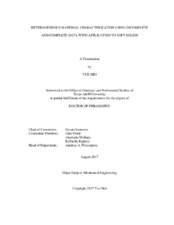| dc.contributor.advisor | Goenezen, Sevan | |
| dc.creator | Mei, Yue | |
| dc.date.accessioned | 2018-02-05T21:21:07Z | |
| dc.date.available | 2019-08-01T06:53:30Z | |
| dc.date.created | 2017-08 | |
| dc.date.issued | 2017-07-20 | |
| dc.date.submitted | August 2017 | |
| dc.identifier.uri | https://hdl.handle.net/1969.1/166035 | |
| dc.description.abstract | This dissertation proposes and develops novel features into the existing inverse algorithms for characterizing nonhomogeneous material properties of soft solids. Firstly, a new feature that material properties are defined as a piece-wise constant in each element has been implemented in the inverse program. Secondly, to reduce boundary sensitivity of the solution to the inverse problem in elasticity, we modify the objective function using a spatially weighted displacement correlation term. Compared to the conventional objective function, the new formulation performs well in preserving stiffness contrast between the inclusion and background. Then, we present an approach to estimate the nonhomogeneous elastic property distribution using only boundary displacement datasets. We further improve this approach by using force indentation measurements to quantitatively map the elastic properties and analyze the sensitivity of this approach to a variety of factors, e.g., the location and size of the inclusion. Furthermore, we present a method to quantitatively determine the shear modulus distribution using full-field displacements with partially known material properties on the boundary and without any traction or force information. We test its performance using two different types of regularization: total variation diminishing (TVD) and total contrast diminishing (TCD) regularizations. We observe that TCD regularization is capable of mapping the absolute shear modulus distribution, while TVD regularization fails to achieve this. Furthermore, we investigate the feasibility of using the linear elastic inverse solver to solve inverse problems for nonlinear elasticity for large deformations. We conclude that the linear elastic approximation will overestimate the stiffness contrast between the inclusion and background. We also extend the inverse strategy to map the orthotropic linear elastic parameter distributions. The reconstructions reveal that this method performs well in the presence of low displacement noise levels, while performing poorly with 3% noise. Finally, a feature that maps the viscoelastic behavior of solids using harmonic displacement data has been implemented and tested.
In summary, these new features not only strengthen our understanding in solving the inverse problem for inhomogeneous material property characterization, but also provide a potential technique to characterize nonhomogeneous material properties of soft tissues nondestructively that could be useful in clinical practice. | en |
| dc.format.mimetype | application/pdf | |
| dc.language.iso | en | |
| dc.subject | inverse problem in elasticity | en |
| dc.subject | heterogeneous material characterization | en |
| dc.subject | computational biomechanics | en |
| dc.title | Heterogeneous Material Characterization Using Incomplete and Complete Data with Application to Soft Solids | en |
| dc.type | Thesis | en |
| thesis.degree.department | Mechanical Engineering | en |
| thesis.degree.discipline | Mechanical Engineering | en |
| thesis.degree.grantor | Texas A & M University | en |
| thesis.degree.name | Doctor of Philosophy | en |
| thesis.degree.level | Doctoral | en |
| dc.contributor.committeeMember | Freed, Alan | |
| dc.contributor.committeeMember | Muliana, Anastasia | |
| dc.contributor.committeeMember | Righetti, Raffaella | |
| dc.type.material | text | en |
| dc.date.updated | 2018-02-05T21:21:09Z | |
| local.embargo.terms | 2019-08-01 | |
| local.etdauthor.orcid | 0000-0002-6773-600X | |


